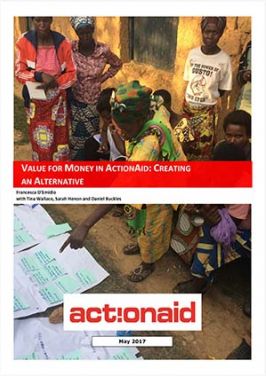Value for money: Creating an alternative
Since 2010, donors increasingly require International Non-Governmental Organizations (INGOs) to demonstrate the Value for Money (VfM) of their interventions.
Executive summary
Since 2010, donors increasingly require International Non-Governmental Organizations (INGOs) to demonstrate the Value for Money (VfM) of their interventions. The framework was imported from the private sector and usually assumes that the goal of VfM assessments is to save money. It also assumes that the changes that INGOs work towards – which are often influenced by complex factors - can be planned, delivered and measured in an orderly and predictable way.
While VfM practices have proven to be difficult for INGOs to use, the VfM agenda does offer an opportunity for aid agencies to look strategically and more analytically at their work, to relate the costs of their interventions to changes achieved and to understand which changes have most value for different people in the community and why. ActionAid committed to understanding how the concept of VfM might be used in a human rights based organization that works to empower the most vulnerable and excluded, in particular women, in very remote areas. Through its VfM Pilot Project, ActionAid developed an alternative approach to VfM, building on practice, learning-by-doing with ActionAid frontline staff, partner staff and the women and men it works with on the ground.
ActionAid believes that the value of a programme should be judged on how much social change it has generated and the communities themselves can best assess this value. Hence, VfM analysis aims to answer the following questions: (i) What is changing as a result of ActionAid’s work and what is not changing as much? (ii) Which areas are worth the investment? (iii) What does ActionAid need to do differently in the future?
To respond to these questions, ActionAid and partners developed a set of participatory tools to enable discussions with the communities about the VfM of its work. ActionAid sought to develop an approach that would enable an understanding of which approaches it invests in have the greatest positive impact. This in turn would help to realign the way budgets are allocated. It is also intended to ensure that those participating can have a real say in how budgets should be allocated and to start the process of reversing the top down power dynamic that currently characterises much development work.
The assessment of VfM starts with the changes that people observed in their community and relates these to investment levels (high, medium and low). Findings are then visualized in a VfM Cartesian Diagram and used to launch as discussion of corrective action, when necessary.
The community-based analysis can be a strong analytical tool to assess the way organizations are investing their resources and to see which approaches are creating more value in communities. The analysis gives priority to the feedback of the communities as the main actors providing the crucial information on which to make VfM judgements. This contrasts with conventional VfM approaches that focus attention on financial management issues which, while important, should not lie at the heart of the question about whether or not VfM is achieved. ActionAid’s approach to VfM goes beyond the analysis of operational systems. Using participatory methods, it empowers community members to assess the VfM of programmes, and supports dialogue, emergent learning and critical reflections on whether investments are generating the best possible changes for people living in poverty. At the same time, it is an approach that can be adopted by frontline staff and partners as the tools developed are simple to use, but rigorous and participatory. This ensures that they can be used on a regular basis to feed into programme planning on the ground.
ActionAid’s alternative approach to VfM offers an opportunity to foster learning and enables constant improvement to achieve greater and deeper impact. In this way, VFM becomes part of a wider accountability agenda, linked to ActionAid’s dual commitment to transparency regarding its programming and decision-making, and accountability as to how it assesses its successes and learns from these in order to improve its work
